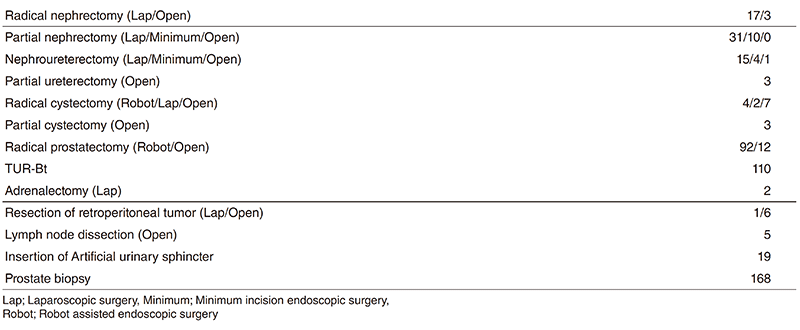Annual Report 2018
Department of Urology
Hitoshi Masuda, Masaharu Inoue, Shugo Yajima, Motohiro Fujiwara
Introduction
The Department of Urological Surgery has existed as part of the Department of Pelvic Surgery at the National Cancer Center Hospital East from 2003. This Department mainly treats all urogenital malignant diseases, including kidney cancer, urothelial cancer, prostate cancer, testicular germ cell tumors, and retroperitoneal sarcomas. We usually perform minimally invasive surgeries such as robotic, laparoscopic and minimum incision endoscopic surgery with preserving the sexual and/or voiding functions in prostate cancer and organ function, especially in kidney cancer.
The Team and What We Do
Outpatient activities: An outpatient clinic is open three days a week as a Urology Department. Flexible cystoscopy, abdominal ultrasonography, retrograde pyelography and prostate biopsy are performed in the outpatient clinic. Superficial bladder cancer (G3, cis, or recurrent tumor) after TUR-Bt is treated by instillation of BCG into the bladder. Advanced urogenital cancers including metastatic prostate cancer are referred to the medical oncology division for chemotherapy or hormonal therapy. Extrinsic obstructions of the upper urinary tract that directly result from invasion of an adjacent malignancy or peritoneal metastasis are also treated. Selection of internal stenting or percutaneous nephrostomy depends on malignancy type and degree of obstruction. Sixty-two patients newly received ureteral stents and 28 underwent nephrostomy for obstructive uropathy in 2018. Moreover, 53 patients newly received insertion of markers or spacers for radiation therapy for localized prostate cancer in 2018.
Inpatient activities: A daily conference is held for diagnosis and treatment of the patients with urological cancer.
Surgeries, especially in robotic prostate surgery, increased dramatically in 2018. In the department of urology, 220 general anesthesia surgeries, 165 spinal anesthesia surgeries and 168 prostate biopsies were performed in this year. (Table 1). Also, we performed 21 combination surgeries with colorectal surgeons in 2018.


We newly started robot-assisted radical cystectomy and artificial urethral sphincter for severe incontinence after prostate surgeries.
Other: We have a conference on urogenital cancers every other week among medical oncologists, radiation oncologists, and pathologists. Neoadjuvant chemotherapy for muscle invasive bladder cancer, combination therapy of hormone and radiation for prostate cancer, treatment strategies for metastatic renal cell carcinoma and testicular cancer, and so on, are determined in the meeting.
Research activities
1. We reported on our initial experience with a novel style of 3-dimensional printed kidney in minimally invasive off-clamp partial nephrectomy.
2. We presented the usefulness of kidney parenchymal ligation in laparoscopic offclamp partial nephrectomy.
3. We also investigated the risk factors of progression of high-risk superficial bladder cancer.
4. We also investigated the usefulness of novel techniques of robot-assisted radical prostatectomy.
Clinical trials
1. A phase II clinical study of robotic-assisted radical prostatectomy by da Vinci S/Si Surgical System
2. A phase III study: BCG instillation for high grade T1 bladder cancer (JCOG1019)
3. A phase III study: Pirarubicin instillation after nephroureterectomy for upper tract urothelial carcinoma (JCOG1403)
4. Examination of the usefulness of the Resonance, the first metallic ureteral stent in Japan, to treat ureteral stricture due to extrinsic compression.
5. A phase II clinical study: Penbrolizumab in high-risk NMIBC unresponsive to BCG (MK3475-057)
6. A phase III clinical study: Penbrolizumab in MIBC (MK-3475-866)
Education
We accepted two voluntary residents of urology in 2018 and educated them on urological surgery.
Future prospects
New transurethral surgical devices for bladder cancer are being developed in cooperation with another institution. Also, we aim for the safe introduction of laparoscopic partial nephrectomy and a safe adaptation expansion of robot-assisted laparoscopic surgery.
List of papers published in 2018
Journal
1. Kijima T, Tanaka H, Koga F, Masuda H, Yoshida S, Yokoyama M, Ishioka J, Matsuoka Y, Saito K, Kihara K, Fujii Y. Selective tetramodal bladder-preservation therapy, incorporating induction chemoradiotherapy and consolidative partial cystectomy with pelvic lymph node dissection for muscle-invasive bladder cancer: oncological and functional outcomes of 107 patients. BJU Int, 2019
2. Yajima S, Yoshida S, Takahara T, Arita Y, Tanaka H, Waseda Y, Yokoyama M, Ishioka J, Matsuoka Y, Saito K, Kihara K, Fujii Y. Usefulness of the inchworm sign on DWI for predicting pT1 bladder cancer progression. Eur Radiol, 2019
3. Kawamura N, Saito K, Inoue M, Ito M, Kijima T, Yoshida S, Yokoyama M, Ishioka J, Matsuoka Y, Kihara K, Fujii Y. Adherent Perinephric Fat in Asian Patients: Predictors and Impact on Perioperative Outcomes of Partial Nephrectomy. Urol Int, 101:437-442, 2018
4. Komai Y, Gotohda N, Matsubara N, Takeda H, Yuasa T, Inoue M, Yamamoto S, Yonese J. Preliminary Kidney Parenchymal Ligation Using Endoloop Ligatures-A Simple Method to Achieve a Trifecta in Laparoscopic Partial Nephrectomy Without Hilar Clamping for Polar Complex Tumors. Urology, 121:182-188, 2018
5. Tanaka H, Yoshida S, Koga F, Toda K, Yoshimura R, Nakajima Y, Sugawara E, Akashi T, Waseda Y, Inoue M, Kijima T, Yokoyama M, Ishioka J, Matsuoka Y, Saito K, Kihara K, Fujii Y. Impact of Immunohistochemistry-Based Subtypes in Muscle-Invasive Bladder Cancer on Response to Chemoradiation Therapy. Int J Radiat Oncol Biol Phys, 102:1408-1416, 2018
